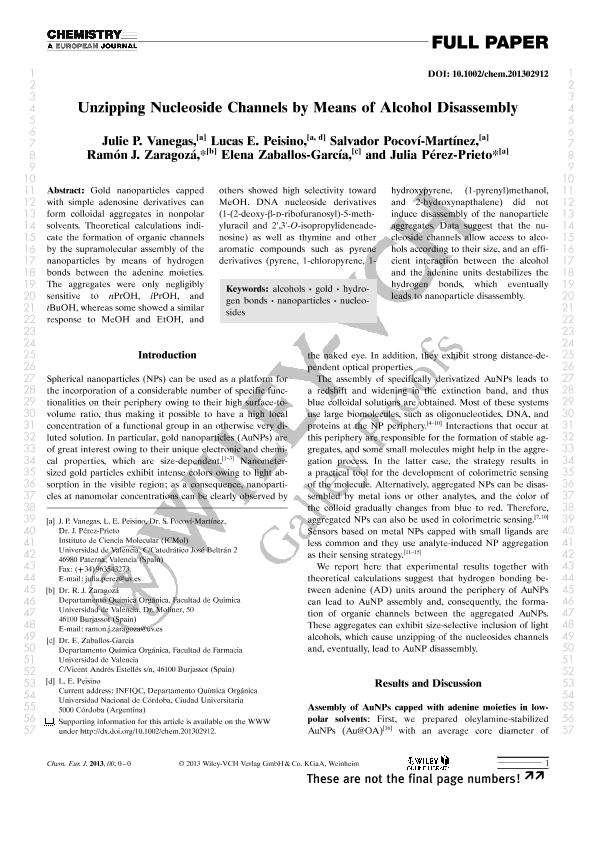Artículo
Unzipping nucleoside channels by means of alcohol disassembly
Vanegas, Julie P.; Peisino, Lucas Ernesto ; Pocoví Martínez, Salvador; Zaragozá, Ramón J.; Zaballos García, Elena; Pérez Prieto, Julia
; Pocoví Martínez, Salvador; Zaragozá, Ramón J.; Zaballos García, Elena; Pérez Prieto, Julia
 ; Pocoví Martínez, Salvador; Zaragozá, Ramón J.; Zaballos García, Elena; Pérez Prieto, Julia
; Pocoví Martínez, Salvador; Zaragozá, Ramón J.; Zaballos García, Elena; Pérez Prieto, Julia
Fecha de publicación:
10/2013
Editorial:
Wiley VCH Verlag
Revista:
Chemistry - A European Journal
ISSN:
1521-3765
Idioma:
Inglés
Tipo de recurso:
Artículo publicado
Clasificación temática:
Resumen
Gold nanoparticles capped with simple adenosine derivatives can form colloidal aggregates in nonpolar solvents. Theoretical calculations indicate the formation of organic channels by the supramolecular assembly of the nanoparticles by means of hydrogen bonds between the adenine moieties. The aggregates were only negligibly sensitive to nPrOH, iPrOH, and tBuOH, whereas some showed a similar response to MeOH and EtOH, and others showed high selectivity toward MeOH. DNA nucleoside derivatives (1-(2-deoxy-β-D-ribofuranosyl)-5-methyluracil and 2′,3′-O-isopropylideneadenosine) as well as thymine and other aromatic compounds such as pyrene derivatives (pyrene, 1-chloropyrene, 1-hydroxypyrene, (1-pyrenyl)methanol, and 2-hydroxynapthalene) did not induce disassembly of the nanoparticle aggregates. Data suggest that the nucleoside channels allow access to alcohols according to their size, and an efficient interaction between the alcohol and the adenine units destabilizes the hydrogen bonds, which eventually leads to nanoparticle disassembly.
Palabras clave:
Alcohols
,
Gold
,
Nucleosides
,
Nanoparticles
Archivos asociados
Licencia
Identificadores
Colecciones
Articulos(INFIQC)
Articulos de INST.DE INVESTIGACIONES EN FISICO- QUIMICA DE CORDOBA
Articulos de INST.DE INVESTIGACIONES EN FISICO- QUIMICA DE CORDOBA
Citación
Vanegas, Julie P.; Peisino, Lucas Ernesto; Pocoví Martínez, Salvador; Zaragozá, Ramón J.; Zaballos García, Elena; et al.; Unzipping nucleoside channels by means of alcohol disassembly; Wiley VCH Verlag; Chemistry - A European Journal; 19; 48; 10-2013; 16248-16255
Compartir
Altmétricas



